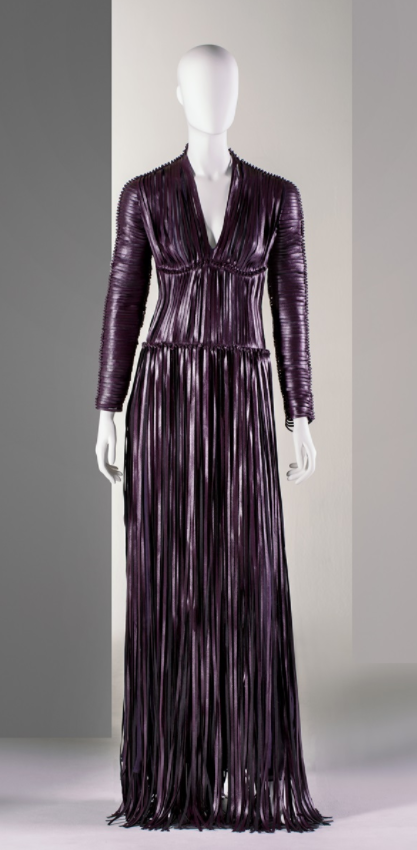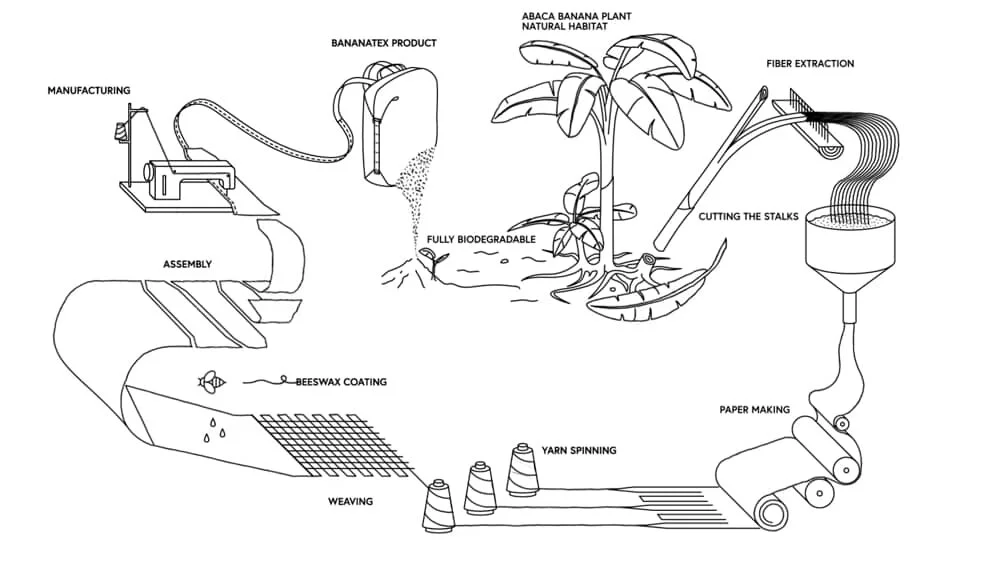From Fruit to Fabrics (Part 2)
Have your fruits and... wear them too?
While you can’t literally grow T-shirts from trees (maybe not yet?), these brands below have brought a revolution to the fashion industry by regenerating fibres from fruits and veggies.
Food-derived garments or biofabrics, are seen as one of the solutions to pollution and waste issues that plague the fashion industry, and surrounding communities that rely on them for a living. Aside from mitigating pollution and excessive chemical use, biofabrics, especially those derived from food waste, are much lighter on the environment.
By the way, check out Part 1 of the topic here!
Vegea
Fancy a glass of wine? Well, Vegea came up with the ingenious idea of combining fashion and wine, by repurposing grape waste into leather. The “grape leather” is also referred to as Vegeatextile®.
Vegea’s grape leather.
Tiziano Guardini’s creation, made from Vegea.
Francesco Merlino together with Gianpieero Tessitore spent years researching the different characteristics of vegetable fibers, and how they could possibly be turned into a more sustainable, and animal-free alternative to leather. The answer lies in the byproducts of winemaking, namely grape skins, seeds, and stems, otherwise known as grape marc. Grape marc are generally discarded or burned as a means of waste disposal during wine production. Considering Italy’s massive wine production industry that supplies 18% of the world’s wine, that’s a lot of grape waste which could be put to good use according to the founders.
To produce the grape leather, Vegea procures grape marc from wine manufacturers and dries them in a process that produces renewable water. Using customized technology and machinery from the leather-making industry, Vegea then processes, treats, and finishes the dried marc to produce leather-like properties. Unlike bovine leathers and its plastic-based alternatives, Vegea requires very little additional water input. As for every 10 liters of wine produced, 2.5 liters of its waste are leftovers, from which roughly one square meter of Vegeatextile® can be produced. Plus, the entire process doesn’t involve hazardous solvents or heavy metals.
Fashion designer and 2017 Green Carpet Fashion Award winner, Tiziano Guardini used Vegea to put together a deep purple gown as part of his first collection, marking the start of Vegea’s foray into the fashion world. In that same year, Vegea was awarded the H&M Global Change Award, which funds the continued RnD processes of the company. Eventually the material was used in H&M’s 2020 Conscious collection, and in sandals by &Other Stories.
AppleSkin by FRUMAT
Based in Italy, FRUMAT transforms apple waste into leather, the AppleSkin. How cool is that?
While any product that upcycles waste material is always a plus in our books, AppleSkin is also totally compostable and recyclable. The resulting product also looks and feels just like leather, goes to show that sustainable material is totally achievable without compromising on appearance or quality.
The exact process is a trade secret, and is patented by FRUMAT. FRUMAT recovers apple waste which are byproducts of juicing apples on an industrial or commercial scale. The pulpy waste is made up of cellulose fibres, which forms the backbone of the leather, thus fewer virgin materials are required. Lesser virgin materials equates to lesser natural resources being extracted from the planet, hence lower emissions and energy consumption across the entire supply chain.
While the use of AppleSkin spans across fashion and furniture industries due to its durability, FRUMAT also has a line of paper products, dubbed ‘Apple Paper’. Apple Paper comes in a number of versions of different properties, and is already being widely employed in stationery, tissue, and packaging production.
The company’s goal for the future is a 100% circular product, which means that the entire product can be kept in a loop, aka it can be broken down, reprocessed, and reused again and again.
Fruitleather
Fruitleather is the brainchild of a team of six undergraduate students from the Netherlands. While researching for their classroom project, the team came to the realization that fruit vendors would illegally dispose of kilos and kilos of waste on a daily basis, to avoid paying extra money for proper disposal.
The team decided to take matters into their own hands. Fruitleather Rotterdam, as the project is named, salvages leftover apples, mangoes, etc to create a vegetal leather. Their primary goal is to create a circular business by repurposing fruit waste, while spreading awareness about food waste.
Although the process is strictly confidential, it is known that after the collection of fruit waste, the seeds are removed, and the rest of the fruit is cut and mashed into a pulp. The pulpy substance is then boiled to remove bacteria so that mould and rotting would not occur. The substance is then dried on a surface to form a sheet, ready to be processed into a leather-like material. Even though there isn’t a lot of visual evidence from the project due to its secrecy, the team has made handbags and even lamp shades from this revolutionary material!
The team is currently increasing the tenacity and durability of the product, as well as upping their manufacturing capacity, so that Fruitleather could find its way into mainstream commercial markets.
Bananatex
We’re going bananas for Bananatex! It’s the world’s first technical fabric made from Abacá banana trees — the stalks, to be exact, that are cultivated in the Philippines.
Bananatex is the result of Swiss backpack brand QWSTION, a Taiwanese yarn specialist and a weaving partner also based in Taiwan. The five QWSTION co-founders share an aim to create their own unique material, as often the largest part of textile production involves plastic, which we all know is not in the planet’s best interest. “Developing our own materials for us is the key to increased sustainability,” says the brand.
Thus began their three-year research to develop a circular, zero-waste fabric that they could use in their collections, resulting in Bananatex. The Abaća banana trees are organically cultivated, with no pesticides or extra water to grow. The stalks even fully regenerate within a year, making it an endlessly renewable source for the textile without being resource-intensive.
The fabric is waterproof too, thanks to a natural beeswax coating. On top of that, the dyes applied to the yarns are Oeko-Tex® Standard 100 certified. Leaving no stone unturned, bags from QWSTION are made with the least waste possible, with each pattern carefully considered to eliminate waste after cutting individual parts that make up the bag.And best of all? You can put your used Bananatex products in your kitchen compost for it to biodegrade and close the loop!
Green Nettle Textiles
Based in Kenya, Green Nettle Textiles convert stinging nettle stalks into linen-like fabrics. So what exactly are stinging nettles?
Stinging nettle is native on Kenyan soils, traditionally used for medicinal and nutritional purposes. It is also extremely low-maintenance, as it grows on any type of soil, and requires little water and sunlight to thrive. While the stalks can be transformed into high quality fabric, its leaves can be converted into paper and dyes. Talk about multipurpose.
The company whose co-founders are Jonah Mwangi, Esther Muthoni, Sophia Mwai, and Susan Macharia had the mission to address environmental issues faced in steep areas riddled with thin soil and sloppiness. By cultivating stinging nettles, not only are they able to boost the economy by providing jobs to over 200,000 smallholder farmers across Kenya, but also preventing soil degradation and erosion. This revolutionary approach of transforming nettle stalks into fabric has won the company a Global Change Award from H&M in 2019.
“Winning the Global Change Award and the grant means our project will get the global recognition and credibility we need to scale up our business and engage more local partners. The mentorship gives us opportunities to improve our product lines and, in the end, our production costs. The grant, however, will be used to prepay farmers, improve our production facilities, to benchmark and research,” says one of the founders, Jonah Mwangi from Green Nettle Textile. And we can’t wait to see their developments in the years to come.
It seems that most of the biofabrics that we’ve talked about came from a shared concern about a major social issue of our times, i.e food waste. Food byproducts are generally irresponsibly discarded, or burned, without any regards to the effect it has on the environment. These innovative companies saw potential in these wastes, like how some would say, “one person’s trash in another person’s treasure”.
Fashion as we know it to be, polluting and unethical, might change in the years to come, as it’s thanks to brands that continually strive to make the planet a better place, one step at a time. From conducting research, sourcing, development, to providing job opportunities, these companies pave the way for a cleaner, more sustainable world.
If you’re interested in integrating sustainability into your current garment production, it can be challenging yet daunting to figure it all out on your own, but we can help! Part of our product lineup is composed of pineapple and coconut waste too! Take a look at our sustainable technologies that don't compromise on performance, and feel free to send us a message to find out more and request fabric swatches!








